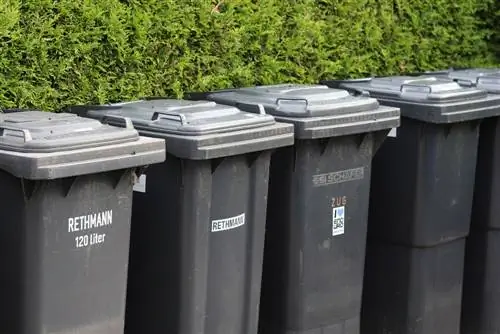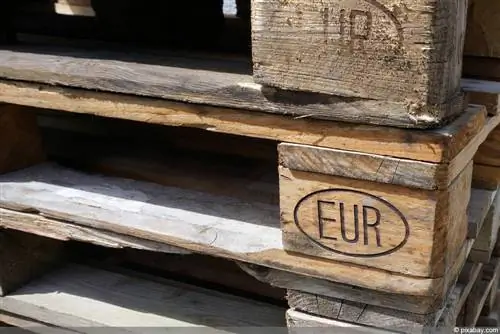- Author admin [email protected].
- Public 2023-12-17 03:39.
- Last modified 2025-01-24 12:45.
Trash cans stink. That's why they are always a cause for arguments and arguments. We explain where garbage cans have no place and where they are correctly placed.
Legal framework
First and foremost, of course, are the unchangeable framework conditions when it comes to the location of garbage cans - i.e. the legal requirements. Unfortunately, the regulations of the following legal areas relating to garbage cans are subject to the regulatory horizon of the countries and can therefore vary from country to country:
- State building regulations
- Development plan
- Local statutes
- Immission Control Act or Ordinance
- Neighborhood Law
- etc.
In specific individual cases, the respective municipality is a well-suited contact point for information on the most common regulatory horizons on the subject of garbage cans.
NOTE:
Legal regulations can prohibit certain locations as well as designate areas for a permissible installation location!
Sensible legal recommendations
Although this provision has not been incorporated into all state laws, you can follow a basic rule for your garbage cans in order to skilfully avoid the biggest difficulties: Keep your cans at least 2.00 meters or more away from windows in common rooms, i.e. bedrooms, living rooms or children's rooms. Many state building regulations are based on the federal model building regulations and specify exactly this distance for so-called “dung sites”. Of course, a garbage can cannot be compared one-to-one with an agricultural dung heap. The law, on the other hand, sees no differences here and includes domestic garbage cans.
Tip:
This regulation is primarily aimed at protecting neighbors in your own house or on the neighboring property. Ideally, you should also take the distances into account in your own house to keep unpleasant smells and flies away from the living spaces!
Practical chosen locations

Now, in addition to the legal framework, there are of course purely practical aspects that define the ideal location for your garbage cans. Unfortunately, however, it is always important to weigh up opposing aspects and give preference to the individually more important topic:
Distances
As close to the house as possible for easy access when throwing out the trash
But also:
- Great proximity to the road for short distances on the day of emptying
- Minimum distance from the house due to odor nuisance
Accessibility and accessibility
- Easy access for easy disposal
- Therefore, as open a location as possible without additional doors, flaps, etc.
But also:
- hardly visible area, due to dirt and generally unattractive barrels
- more difficult access for (wild) animals to organic waste
- Shading to prevent excessive heating of the waste (fermentation, odor formation, spread of insects, etc.)
Ventilation
- well ventilated area to prevent intense odors
- ideally a location that can be ventilated on all sides to prevent summer overheating (odor nuisance, insect proliferation, fermentation of organic waste)
But also:
- optically motivated separation
- no location in the main wind direction to the terrace, seating area, kitchen / living room window etc. (odor nuisance)
Explained using example
For example, a location directly at the entrance to the house is not ideal for avoiding odor nuisance as best as possible and at the same time being as invisible as possible. On the other hand, a location that is difficult to see often makes it difficult for containers to reach the street. In some cases it may even happen that certain requirements for the “perfect” bin parking space simply cannot be met due to local conditions, be it because of the development, the topography or simply because of a limited amount of land.
Alternative solutions
In these cases, it is important to design the containers optimally for the benefit of all surrounding residents. Garbage boxes offer good opportunities to compensate for locational disadvantages:
Enclosures
Side enclosures provide the desired seclusion and also make access to the garbage more difficult for all sorts of unwanted animal visitors.
Overlays
On the one hand, covers in the form of roofs also help to create “invisible” garbage cans, but at the same time they also reduce sunlight and thus the development of unpleasant smells.
Greenings
In addition to greenery, ventilation openings can also be created in garbage boxes or enclosed storage areas that visually disappear behind loose vegetation. Sometimes well-chosen plants are even able to mask unwanted garbage smells.






